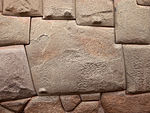
The tupiq (dual: tupiik, plural: tupiit, Inuktitut syllabics: ᑐᐱᖅ) is a traditional Inuit tent made from seal or caribou skin. An Inuk was required to kill five to ten ugjuk (bearded seals) to make a sealskin tent. When a man went hunting he would bring a small tent made out of five ugjuit. A family tent would be made of ten or more ugjuit.
Fabrication and use
After the bearded seal is killed, its fat is scraped off, then the skin is stretched to dry. Finally, women will sew it together to make a tent. Layers can be added by laying heather on top of the outer skin and wrapping another skin around the tent.
The tupiq was used on the land that was not on sea ice or snow. It was portable for travel and lasted several years. When stored over the winter, the tupiq had to be kept away from dogs. In the summer the tupiq was used as shelter, then in the fall when it got colder, the Inuit moved into a qarmaq, a type of sod house, and the tupiq was used for the roof. In winter, the Inuit lived in igluit when the snow was good enough to build them. Then in the spring when the iglu melted, they moved back into the tupiq.
The tupiq was important traditionally, but is rarely used in modern times. Today most Inuit use canvas tents called tupikhaq.
References
- ^ Ohokak, G.; M. Kadlun; B. Harnum. Inuinnaqtun-English Dictionary (PDF). Kitikmeot Heritage Society. Archived from the original (PDF) on 4 September 2012. Retrieved 20 March 2013.
- "16 » The Dual | Inuktut Tusaalanga". tusaalanga.ca. Retrieved 16 September 2024.
- Grant, Shelagh (5 November 2002). "Appendix Three". Arctic Justice: On Trial for Murder, Pond Inlet, 1923. McGill-Queen's University Press. p. 277. ISBN 978-0773529298. Retrieved 20 March 2013.
tupiq plural.
- "Tupiq". Asuilaak Living Dictionary. Retrieved 20 March 2013.
- Larsen, Olga Popovič; Tyas, Andy (1 January 2003). "3". Conceptual Structural Design: Bridging the Gap Between Architects and Engineers. ICE Publishing. p. 19. ISBN 978-0727732354. Retrieved 20 March 2013.
- "Warm Season Dwellings -Tupiq". Archived from the original on 21 October 2013. Retrieved 20 March 2013.
- "Bearded seal". Asuilaak Living Dictionary. Retrieved 20 March 2013.
- Arctic Flora Arctic Journal. 29 April 2019 Archived 29 April 2019 at the Wayback Machine
- Ludger Müller-Wille, ed. (16 June 2016). Franz Boas among the Inuit of Baffin Island, 1883-1884: Journals and Letters. Translated by William Barr. University of Toronto Press. p. 130. ISBN 978-1-4875-1329-0.
Today they covered their Tupiks with heather and pulled another skin over it.
| Tents and overnight shelters | |
|---|---|
| Traditional types | |
| Modern types | |
| Equipment | |
| Related topics | |
| Native American architecture | ||
|---|---|---|
| Styles |  | |
| Building types | ||
| Structures | ||
| Elements | ||
This article about a Canadian building or structure is a stub. You can help Misplaced Pages by expanding it. |